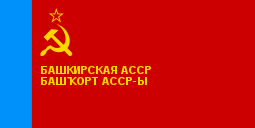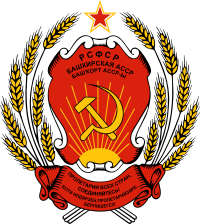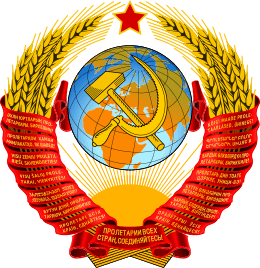Bashkir Autonomous Soviet Socialist Republic
The Bashkir Autonomous Soviet Socialist Republic (Bashkir: Башҡорт Автономиялы Совет Социалистик Республикаhы; Russian: Башкирская Автономная Советская Социалистическая Республика, Bashkirskaya Avtonomnaya Sovetskaya Sotsialisticheskaya Respublika); also historically known as Soviet Bashkiria or simply Bashkiria[1][2] was an Autonomous Soviet Socialist Republic within the Russian SFSR. Currently it is known as Republic of Bashkortostan.[3]
| Bashkir Autonomous Soviet Socialist Republic Башкирская Автономная Советская Социалистическая Республика Башҡорт Автономиялы Совет Социалистик Республикаhы | |||||||
|---|---|---|---|---|---|---|---|
| Autonomous republic of the Russian SFSR | |||||||
| 1919–1992 | |||||||
| Capital | Ufa | ||||||
| Area | |||||||
• 1990 | 143,600 km2 (55,400 sq mi) | ||||||
| Population | |||||||
• 1989 | 3 943 100 | ||||||
| • Type | Autonomous Soviet Socialist Republic | ||||||
| History | |||||||
• Established | 23 March 1919 | ||||||
• Sovereignty declared (Bashkir SSR) | 11 October 1990 | ||||||
• Renamed to Republic of Bashkortostan | 25 February 1992 | ||||||
| |||||||
| Today part of | |||||||
Bashkir ASSR was the first Autonomous Soviet Socialist Republic in RSFSR.[4][5][6]

The republic occupied an area of 143,600 km2 (55,400 sq mi) in the far south-eastern corner of European Russia, bounded on the east by the Ural Mountains and within seventy kilometers of the Kazakhstan border at its southernmost point. The region was settled by nomads of the steppe, the Turkic Bashkirs, during the 13th-century domination by the Golden Horde. Russians arrived in the mid-16th century, founding the city of Ufa, now the republic's capital. Numerous local uprisings broke out in opposition to the settlement of larger Russian populations in the centuries that followed. The Bashkirs finally give up nomadic life in the 19th century, adopting the agricultural lifestyle that remains their primary means of support. The traditional clan-based social structure has largely disappeared. The predominant religions of the Bashkir population are Islam, which is observed by the majority, and Russian Orthodoxy. A major battleground of the Russian Civil War, in 1919 the Bashkir Republic was the first ethnic region to be designated an autonomous republic of Russia under the new communist government. The republic declared its sovereignty within the Soviet Union on 11 October 1990 as Bashkir Soviet Socialist Republic, and in 1992 it declared full independence. Two years later, Bashkortostan agreed to remain within the legislative framework of the Russian Federation, provided that mutual areas of competence were agreed upon.
The republic has rich mineral resources, especially petroleum, natural gas, iron ore, manganese, copper, salt, and construction stone. The Soviet government built a variety of heavy industries on that resource base. The traditional Bashkir occupations of livestock raising and beekeeping remain important economic activities.
See also
- First Secretary of the Bashkir Communist Party
- Kuvandyk corridor
References
- "Башкортостан или Башкирия?/Юлдаш Юсупов - Проект ЗАМАН - первая некоммерческая информационная площадка в Башкортостане, которая объединяет людей науки и культуры". YouTube.com.
- "Можно ли говорить «Башкирия», и оправдан ли гнев части жителей республики по этому поводу? / Аделина Минибаева". UfaTime.ru.
- "Башкирская Автономная Советская Социалистическая Республика". bse.sci-lib.com. Retrieved 2019-12-16.
- Большой Советской Энциклопедии [Great Soviet Encyclopedia]. 4. 1950. p. 347.
- Jonathan D. Smele (November 19, 2015). Historical Dictionary of the Russian Civil Wars,1916-1926. 2. Rowman & Littlefield Publishers. p. 179. ISBN 1442252804.
- The Encyclopedia Americana. 30. Danbury, Conn. : Grolier. 1984. p. 310. ISBN 0717201155.
- Pipes, Richard E. (1950). "The First Experiment in Soviet National Policy: The Bashkir Republic, 1917-1920". Russian Review. 9 (4): 303–319. doi:10.2307/125989.



